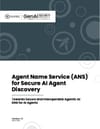📘 What’s Covered
The document proposes ANS as a foundational infrastructure for secure, verifiable, and interoperable AI agent discovery. ANS draws architectural inspiration from DNS, yet expands it with capabilities tailored to multi-agent systems (MAS). It integrates public key infrastructure (PKI) to ensure agent identity and incorporates a modular Protocol Adapter Layer to support diverse agent communication standards like A2A (Google), MCP (Anthropic), and ACP (IBM).
The authors define how agents register and renew credentials using X.509 certificates, and how ANSNames—structured, semantically rich identifiers—enable capability-based discovery. A comprehensive threat model follows, using the MAESTRO 7-layer framework to assess risks like impersonation, registry poisoning, and DoS attacks.
Several technical layers are detailed:
- Naming resolution algorithms, version negotiation, and TTL-based caching strategies.
- Schema definitions using JSON for request/response standardization.
- Adapters for cross-protocol operability, with metadata translation and security validation functions.
- Zero-Knowledge Proofs (ZKPs) and challenge-response protocols for runtime capability validation.
Future directions include privacy-preserving queries (via PIR), formal verification, and governance frameworks. Implementation models (centralized, distributed, federated, hybrid) are compared in terms of latency, fault tolerance, and operational complexity.
Visuals on pages 9, 18, and 34 help clarify the registry architecture, agent resolution workflow, and protocol integration pathways. Appendix B also offers a solid glossary for readers unfamiliar with MAS terms.
💡 Why it matters?
As AI agents shift from isolated tools to autonomous systems collaborating across domains, the need for verifiable identity and secure discovery becomes non-negotiable. ANS provides a standards-based, extensible backbone to enable this trust layer. It’s a significant step toward making agent-to-agent interactions not just possible, but secure and accountable. Its focus on governance, cryptographic assurance, and interoperability directly addresses current regulatory and security concerns surrounding multi-agent ecosystems.
❓ What’s Missing
Despite its technical depth, ANS is currently a conceptual framework. There’s no working implementation or real-world deployment data yet. Governance remains underdeveloped—key questions around name allocation, dispute resolution, and root authority trust are acknowledged but left for future work. Additionally, usability for smaller developers or integration with existing enterprise IAM systems isn’t discussed, which could slow adoption outside of well-funded projects.
🎯 Best For
Ideal for security architects, AI platform engineers, and policymakers working on secure agent interoperability. Also relevant to compliance officers and enterprise architects tasked with multi-agent deployments in regulated sectors like finance or healthcare. Less suitable for teams working solely on single-agent or consumer AI products.
📎 Source Details
Title: Agent Name Service (ANS) for Secure AI Agent Discovery
Authors: OWASP GenAI Security Project contributors
Version: 1.0, May 13, 2025
License: CC BY-SA 4.0
Available at: OWASP GenAI Security Project
Key contributors: Ken Huang, Idan Habler, Ron F. Del Rosario, John Sotiropoulos
Review board: Experts from NIST, SAP, Exabeam, Oracle, The Alan Turing Institute


